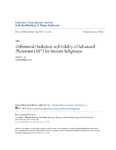Please use this identifier to cite or link to this item:
http://lib.hpu.edu.vn/handle/123456789/25200| Title: | Differential Prediction and Validity of Advanced Placement (AP®) for Student Subgroups |
| Authors: | Lee, Minji K. Randall, Jennifer Sireci, Stephen G. Gile, Krista J. |
| Keywords: | Educational Assessment Educational Evaluation Educational Research |
| Issue Date: | 2016 |
| Publisher: | University of Massachusetts - Amherst |
| Abstract: | Concerns over fairness permeates every aspect of the testing enterprise, and one characterization of fairness in testing defined by the Standards (AERA, APA, & NCME, 1999) is a fairness as lack of bias. One important way to study bias in college admission context concerns the degree to which prediction equations are equivalent for different groups. To the extent that the AP variables are used together with admission test scores and previous academic records to predict future academic achievement, it is important to know if members of one group are systematically predicted to obtain lower or higher grades than they actually achieve on the average (Linn, 1990, p. 309). Many studies have investigated differential predictive validity for different groups using high school performance and admission test scores as predictors (Linn, 1990). To this day, minimal research attention has been directed toward differential predictive validity using Advanced Placement (AP) variables as predictors, although policy makers have begun to treat the AP experience as an additional important prerequisite for success in college (Breland et al., 2002). By examining the differential predictive ability of AP variables and controlling for predictor unreliability, we can better understand the extent to which these predictors are biased against particular groups. With this understanding, test users can be informed of the extent to which the inferences drawn from these variables are supported by strong validity evidence regarding fairness in admission. Against this backdrop, the current study examines whether AP exam scores predict the first year GPA and second year retention differently for different groups of ethnicity, gender, parental education level, and language group, controlling for high-school-level variables using hierarchical linear modeling. |
| URI: | https://lib.hpu.edu.vn/handle/123456789/25200 |
| Appears in Collections: | Sociology |
Files in This Item:
| File | Description | Size | Format | |
|---|---|---|---|---|
| 15_Differential_Prediction.pdf Restricted Access | 2.67 MB | Adobe PDF |  View/Open Request a copy |
Items in DSpace are protected by copyright, with all rights reserved, unless otherwise indicated.
